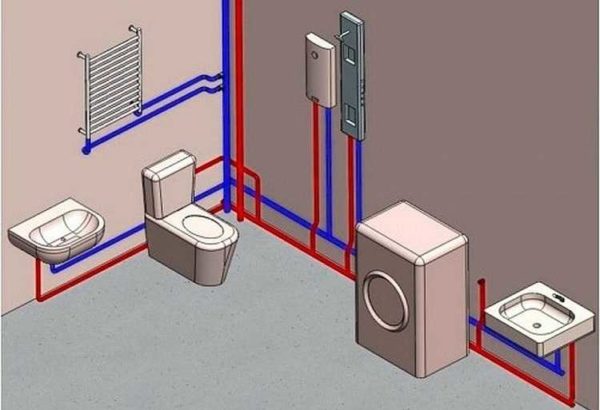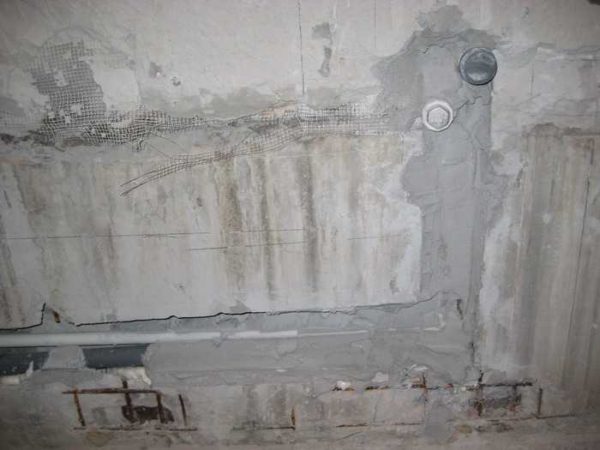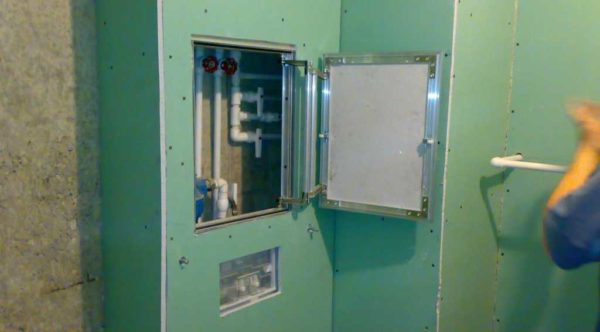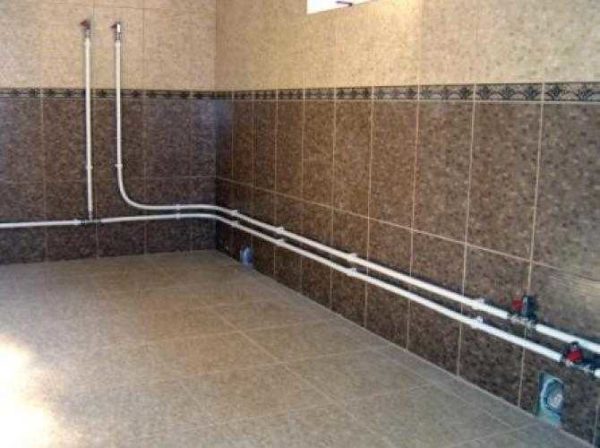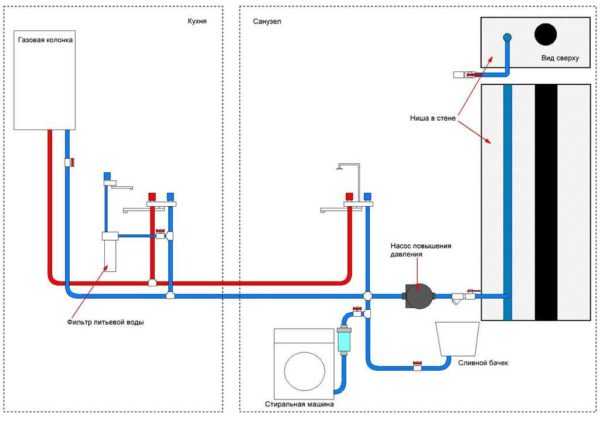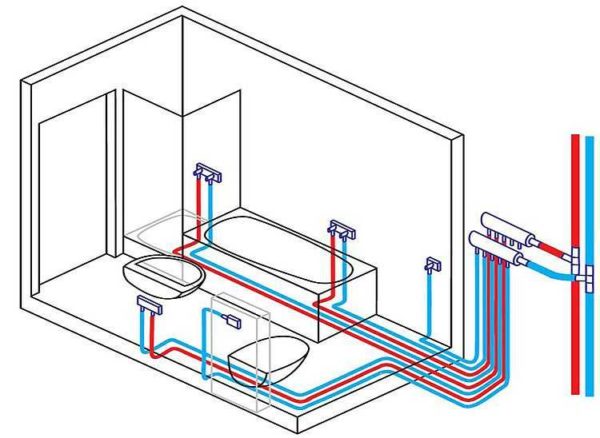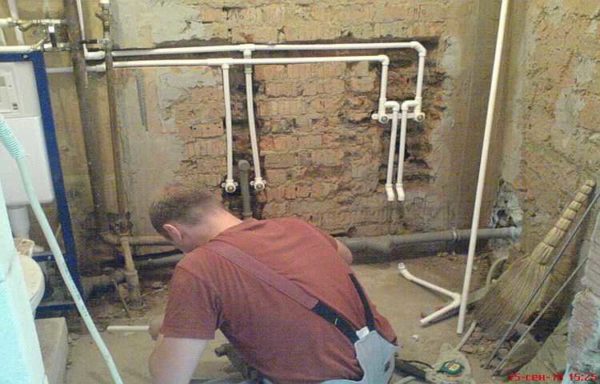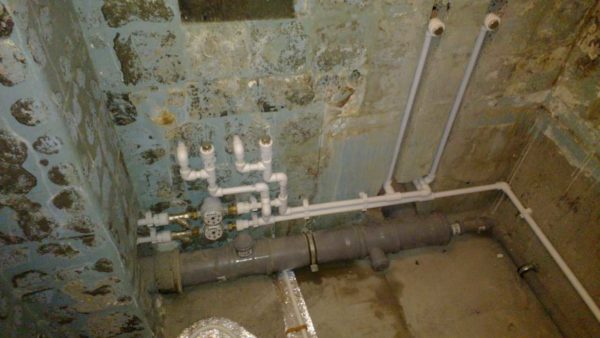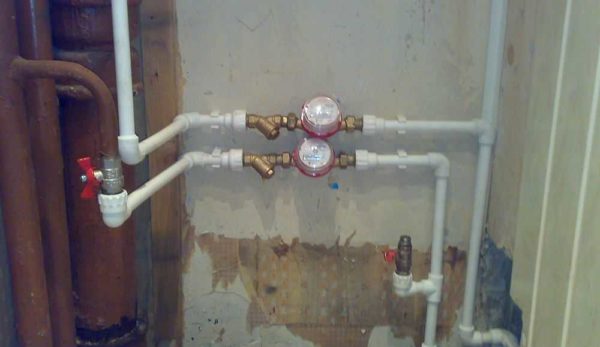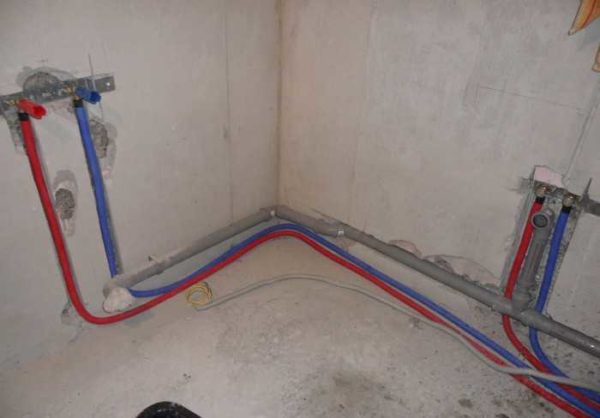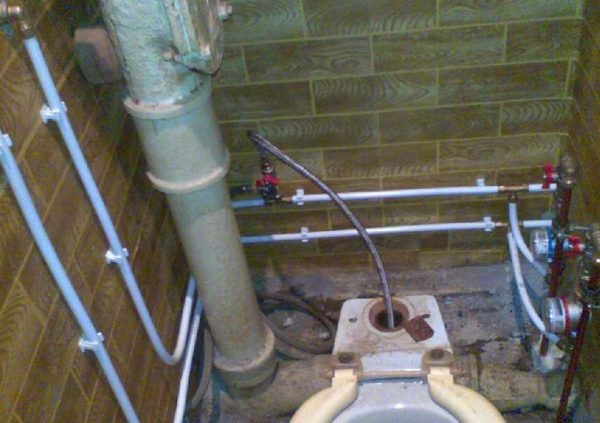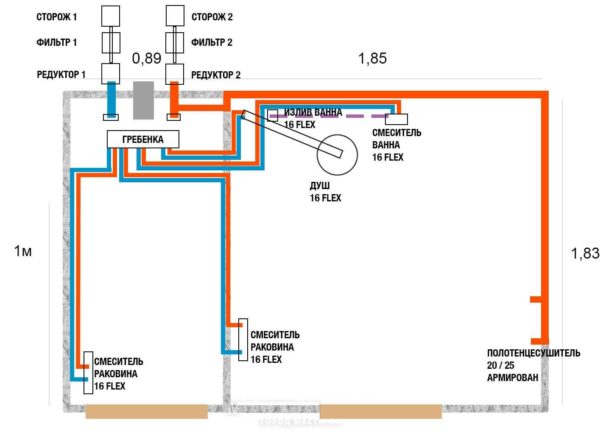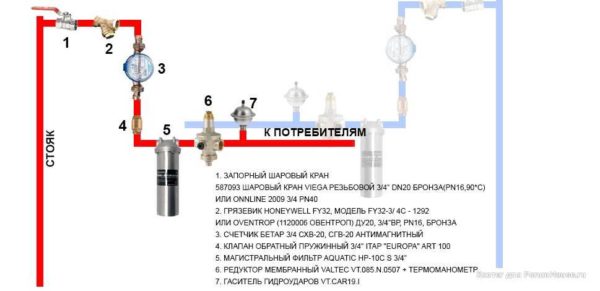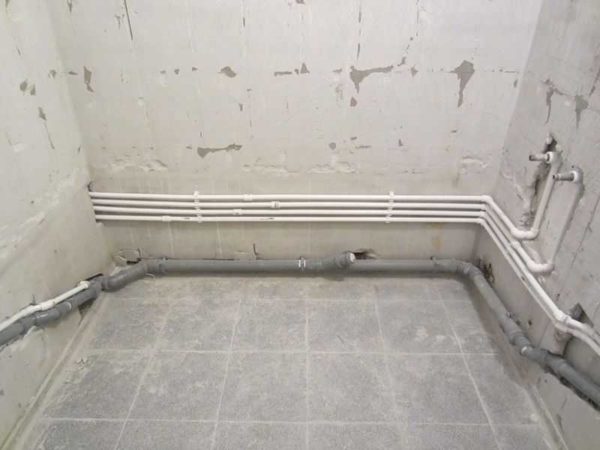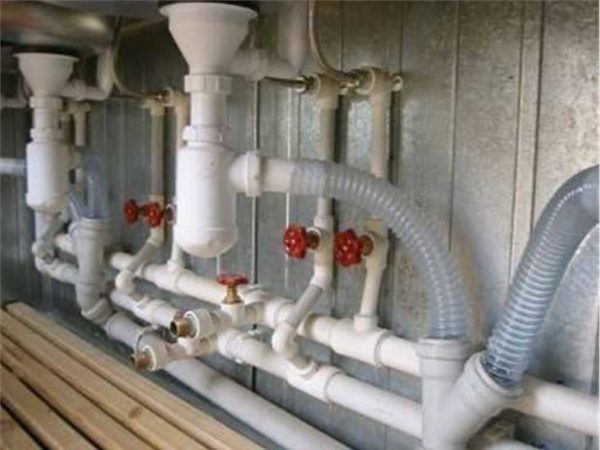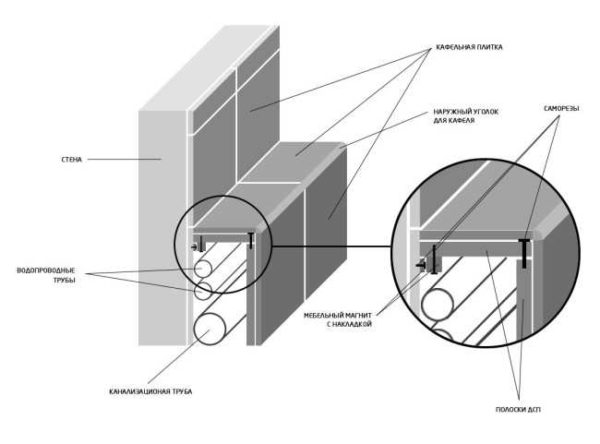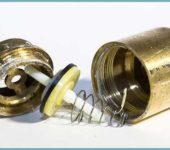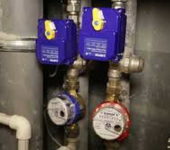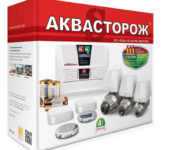Plumbing in the apartment and house
Self-wiring of hot and cold water pipes in an apartment or house is not easy, but real. Even if you are going to hire a specialist, you should know the main points yourself - control will not hurt.
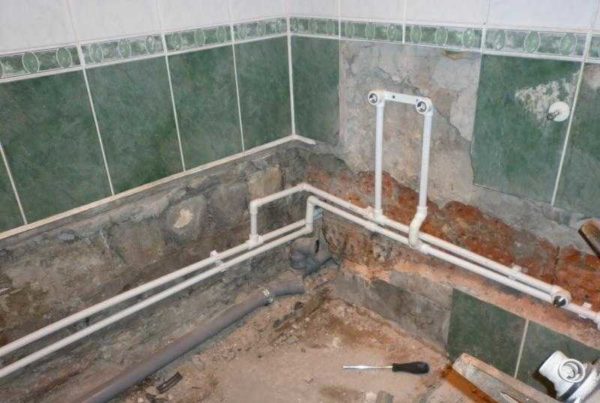
Today, in most cases, piping in the bathroom is made of polymer pipes - polypropylene for water supply, PVC for sewage
The content of the article
How to develop a water pipe layout
First, you determine the places where all consumers of cold and hot water will be located. It is better to do everything on the plan, but you can mark it “on the spot”. Not only the geometric dimensions of the devices are important, but also the exact location of the place where the water should be supplied.
Many devices are connected to the water supply network using flexible hoses. Then the outlet from the line can end 10-20 cm before the device. The main thing is that the connection point is easily accessible. This is necessary for convenient and quick service of the connection. This connection method is easier to implement - there is no need to accurately calculate the length of the pipe.
There is also a hard water supply to plumbing fixtures or household appliances - pipes to the very entrance. Such a connection is more difficult to perform, therefore this type of wiring is less common. Basically, gas water heaters (columns), bathroom faucets, which are attached to the wall, are connected in this way.
External or hidden gasket
First of all, it is worth deciding on the type of pipe laying - they will go on top or hidden in the wall or floor. Hidden wiring in the bathroom, toilet is good from an aesthetic point of view - nothing is visible. But the pipes are inaccessible, in order to eliminate the leak, you will have to break the wall, which is not at all happy. Therefore, they try to lay only whole pieces without joints in the wall - there is less chance of leakage.
There is another difficulty in the hidden laying of a water supply system - the need for channels in the wall (strobe), in which pipes are laid. Firstly, not every wall allows making grooves in it. For example, in panel houses, where the wall thickness is only about 10 cm, it is definitely not worth making a channel 5-6 cm deep. The slab will lose a significant part of its bearing capacity. There is probably no need to explain how this threatens. Secondly, laying strobes in the wall is not the easiest job, even with a puncher it takes a lot of time. So this option has more than enough disadvantages.
Another type of hidden piping is behind a false wall. To do this, retreating some distance from the main wall, install a frame, and drywall on it, on which the tiles are then laid. The second option for a false wall is made of plastic panels.
From a practical point of view, outdoor piping is better - everything is in sight, available for repair at any time. But the aesthetic side suffers. To hide their communications, they all - water supply and sewerage - try to lay closer to the floor, then build on a plasterboard box with a removable lid or top. So all the pipes have free access, and they themselves are almost invisible.
Laying method
In an apartment or house, the plumbing is done in two ways - by connecting all consumers in series or by installing a collector, from which a separate pipe goes to each of the devices. Both options are not without drawbacks.
When pipes are connected in series, little goes away, but if more than two plumbing fixtures are connected in a row, during their simultaneous operation, the pressure may be insufficient. This type of wiring is also called tee - all branches from the main main pipe are made using tees (sometimes crosses or angles).
With the collector wiring of the water supply system, it takes a lot of pipes, in addition, additional equipment is required - a collector for the water supply system. So this piping scheme is an expensive undertaking, but the pressure on all connected devices, regardless of the number of workers, is the same.
There is one more nuance: a large number of pipes must be laid somewhere, moreover, compactly, and this is not easy at all. Therefore, this type of wiring is more often used with hidden laying or with open, but in those places that require such a connection or can be covered with furniture.
For example, in a bathroom or toilet, only two devices are connected. There you can make sequential wiring. A column (boiler), a sink tap, a washing machine and a dishwasher are connected in the kitchen. In this case, it makes sense to put a collector in the kitchen, and from it to separate separate branches of water supply to all consumers. This method of connection is called mixed - part of the water supply system is bred using tees, part from the collector.
Please note that if cold and hot water is wired at the same time, the pipelines are laid in parallel. When the liner is hidden, it makes sense to wrap the hot water supply in thermal insulation - then the water will really be hot and you will not heat the walls. If the pipes are polypropylene or plastic, this is not so critical - polymers have a low heat transfer coefficient. For metal (any - steel, stainless steel, galvanized, copper), thermal insulation is very desirable.
Pipe routing: rules
As in any business, plumbing has its own rules. They also exist when laying a water supply system. If you are going to do the plumbing for yourself, it is up to you to observe them or not, but it is better to do everything right. The rules have their own logic, which most adhere to:
- The pipes should run parallel, it is better that they do not intersect. It is better to lay them not obliquely, but vertically and horizontally. This rule is especially important for hidden installation - so you will know where the pipes go and will not make a hole in them when you try to hang / fix something on the wall.
- It is desirable to have free access to the joints and joints.
- Each branch in front of a plumbing fixture or household appliance ends with a shut-off (ball) valve. It is necessary so that you can remove or repair the device without shutting off the water supply to other consumers.
- When installing the water supply system in the apartment, after the riser, it is imperative to install a coarse filter (further filters optional, but this one should be).
- When laying the water supply system, each branch is made smaller by a step in diameter. This is necessary to maintain a stable pressure. For example, the circuit is sequential, assembled from polypropylene. The riser is 32 mm, the outlet is 20 mm from it, 16 mm goes to consumers (appliances and sanitary equipment).
If you look closely, you will see that most of the water pipes are made according to these rules.
Which pipes for water supply are better
It is impossible to say unequivocally which pipes are best for wiring - there is no ideal material, there are more or less suitable for the given conditions. Let's dwell on the most popular options, their advantages and disadvantages:
Polypropylene pipes
The option is good for everyone, except for a large thermal expansion - up to 5 cm per 1 meter, which is a lot.With a long route, it is necessary to install a compensator or use reinforced pipes. Their thermal expansion is several times less, but the prices are higher. For hot water, you definitely need to use reinforced pipes, but with fiberglass or foil - it's up to you. The layout of cold water pipes can be done with a conventional PPR pipe for cold water - here thermal expansion is not so critical.
Read about the choice of polypropylene pipes here.
Another point that is relevant if you do the work yourself, you are going to do a hidden laying of communications - the quality of the connections. Basically, in soldered polypropylene there is nothing complicated, but without experience you can "screw up", as a result, after a while the connection may leak. In the absence of experience in welding polypropylene, it is very undesirable to hide the joints under the finish. In this case, it is better to choose an open styling method.
The layout of polypropylene pipes in the bathroom and toilet has many positive aspects:
- a properly made connection is monolithic;
- there is no narrowing of the pipeline diameters at the soldering points;
- high maintainability;
- long service life;
- ease of installation.
In general, it is not for nothing that this material has been so popular lately.
PVC for plumbing
When laying PVC pipes, an adhesive connection is used. There is a special glue that dissolves the top polymer layer. Both parts to be glued are lubricated with it, pressed against one another and kept for some time. As a result, the connection is practically monolithic, strong and reliable.
There are two types of connection: butt, when two pipe lengths are joined, and using fittings. Fittings are easier to work with, but the joints are narrower. With a butt joint, there are no narrowings, but it is much more difficult to make it qualitatively.
In principle, all the pros and cons are the same here, a few minuses are added - it is suitable only for transporting only cold environments - no more than + 40 ° C, that is, you will have to use other pipes for hot water supply. Scratches and chips reduce the strength of the pipe, therefore a threaded connection is excluded.
Reinforced plastic
The distribution of the water supply system from metal-plastic pipes is also suitable for hot water supply - it can withstand temperatures up to + 105 ° C. A positive difference from all of the above is its high ductility - these pipes can be bent with a fairly small radius. This simplifies and reduces the cost of installation (fittings are expensive).
The disadvantage of using metal-plastic pipes for water supply is a strong narrowing at the joints - in the fittings. This leads to a significant decrease in system pressure. This is what limits their use.
Examples of circuits
The routing of pipes in each apartment, even in a typical house, is individual - plumbing and household appliances are arranged in different ways, of course, the scheme will be different. In reality, everything is not so difficult, you just need to decide on the main parameters of the circuit - where you need to supply water and the type of wiring - you will pull in parallel or sequentially. Further, everything is dictated by the position of consumers. To make it a little easier, let's add a few more schemes and photos.
The peculiarity of this scheme is that a thicker pipe from the hot water supply goes to the heated towel rail. This is done to provide better heating.
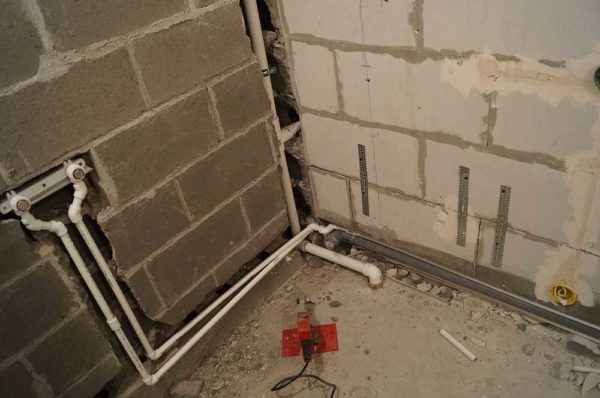
When approaching the installation site of the mixer, it is necessary to accurately maintain the distances
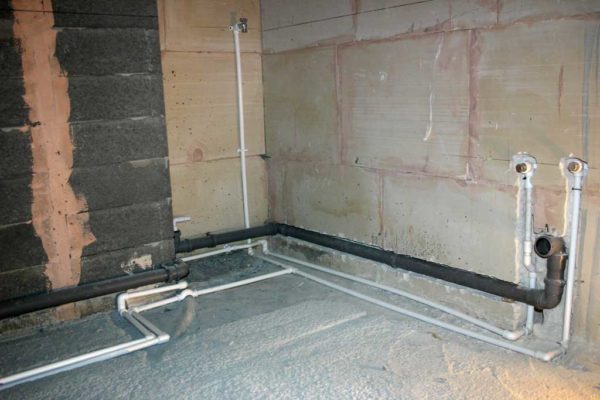
With a hidden installation of the water supply, some of the pipes can be hidden in the floor. It will be impossible to repair them, but beautiful ...

